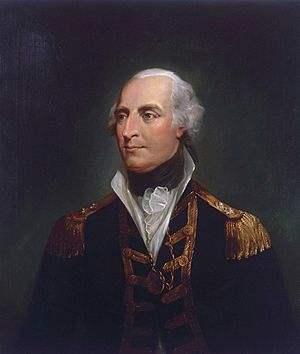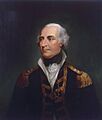Roger Curtis facts for kids
Quick facts for kids
Sir Roger Curtis
|
|
|---|---|

Sir Roger Curtis, ca. 1800
|
|
| Born | 4 June 1746 Downton, Wiltshire |
| Died | 14 November 1816 (aged 70) |
| Allegiance | United Kingdom |
| Service/ |
Royal Navy |
| Years of service | 1762–1816 |
| Rank | Admiral |
| Commands held | HMS Senegal HMS Eagle HMS Brilliant HMS Ganges HMS Queen Charlotte HMS Brunswick HMS Canada HMS Powerful HMS Invincible HMS Formidable Cape of Good Hope Station Portsmouth Command |
| Battles/wars | |
| Awards | Knight Bachelor |
Admiral Sir Roger Curtis, 1st Baronet GCB (1746–1816) was an officer in the British Royal Navy. He took part in many important battles during his long career.
Curtis served during the American Revolutionary War and the French Revolutionary Wars. He was highly praised for his bravery during the Great Siege of Gibraltar, where he saved many Spanish lives. However, his career faced challenges after the Glorious First of June battle. He was criticized by some important figures, including Cuthbert Collingwood. His reputation also suffered due to his involvement in two controversial courts-martial (military trials) in 1795 and 1810.
Later in his career, during the Napoleonic Wars, Curtis mostly worked in shore-based roles and did not see much action. He passed away in 1816. His son, Lucius Curtis, inherited his title and later became a very high-ranking admiral. Today, historians often see Curtis as a careful officer. At the time, some officers admired him, while others did not.
Contents
Roger Curtis was born in 1746 in Wiltshire, England. His father was a farmer, also named Roger Curtis. In 1762, at the age of 16, Roger joined the Royal Navy in Portsmouth. He became a midshipman, which is a junior officer rank, on HMS Royal Sovereign. This was during the final year of the Seven Years' War.
After the war ended in 1763, Curtis served on several ships, including HMS Assistance and HMS Gibraltar. In 1769, he joined the frigate HMS Venus and then HMS Albion. On Albion, he was promoted to lieutenant, another officer rank.
Curtis then joined HMS Otter in Newfoundland. He spent several years exploring the Labrador coastline and learned a lot about the local area and the Inuit people. He wrote reports about the region, suggesting that the coast was good for fishing. He also became friends with the Inuit tribes and missionaries there.
In 1775, Curtis moved to HMS Chatham near New York City. The American Revolutionary War had begun, and in 1776, Curtis was promoted to commander. He was given command of the ship HMS Senegal. He did well in this role and was promoted again a year later. He became captain of HMS Eagle, the flagship of Lord Howe, and they became good friends.
American Revolutionary War Service
In 1778, Curtis returned to Britain on Eagle. He had a disagreement with Lord Sandwich because he refused an order to sail his ship to the Far East. Because of this, Curtis did not have a command for two years.
In 1780, he was given command of the new frigate HMS Brilliant and sent to the Mediterranean. While heading to Gibraltar, his ship was attacked by a larger Spanish fleet. Brilliant had to escape to British-held Menorca. Curtis waited for a large convoy of 25 ships carrying supplies for the defenders of the Great Siege of Gibraltar. He successfully led this convoy into Gibraltar, which was under attack.
During the siege, Curtis led a group of marines. In September 1782, Spanish gunboats attacked. Curtis took his men in small boats into the harbor to fight the enemy. He saw the British destroy the Spanish floating batteries with 'hotshot' (heated cannonballs). Curtis then bravely rescued hundreds of Spanish sailors who were burned and drowning in the water. This rescue was very dangerous because burning Spanish ships were exploding nearby.
After the siege was relieved, Lord Howe brought Curtis back to Britain. Curtis was made a knight for his service and became a well-known figure.
French Revolutionary War Service
In 1793, when the French Revolutionary Wars began, Curtis returned to command HMS Queen Charlotte. He joined Lord Howe and the Channel Fleet. In May 1794, Howe led the fleet to find a French convoy. They eventually found the French Atlantic Fleet and fought two smaller battles.
On June 1, 1794, Howe's fleet fought the French fleet in the battle known as the Glorious First of June. Curtis's ship was heavily involved, fighting several French ships at once.
Towards the end of the battle, Lord Howe became ill, and Curtis took charge of the flagship and, for a short time, the fleet. There were some unusual decisions made, and the British fleet did not chase the defeated French ships, allowing many to escape. Also, a report sent to the Admiralty about the battle praised some officers but left out others. This meant some captains did not receive awards for their bravery. Many people blamed Curtis for this, and it was rumored he wrote the report himself.
Curtis was given a special title, a baronetcy, for his role in the battle. However, another captain, Anthony Molloy, faced a court-martial for not engaging the enemy enough during the battle. Curtis was the prosecutor in this case, and Molloy was removed from the navy. Some officers, like Cuthbert Collingwood, were unhappy with Curtis, describing him as someone who tried to gain all the honors for himself.
After this, Curtis briefly commanded several other ships. In 1796, he was promoted to rear-admiral. He led the blockade of Brest and helped with naval operations during the Irish Rebellion of 1798. Later, he joined Lord St Vincent off Cadiz and was promoted to vice-admiral in 1799. He then retired from active sea duty.
Shore-Based Service
Curtis's remaining career involved working at various shore stations. From 1800 to 1803, he was commander-in-chief at the Cape of Good Hope Station in Cape Town. In 1804, he was promoted to full admiral. From 1805 to 1807, he worked on a commission to improve the navy's civil affairs, where he introduced many helpful changes.
In 1809, after 40 years of service, Curtis took his final command as Commander-in-Chief, Portsmouth. In 1810, he oversaw a controversial court-martial for Lord Gambier regarding the Battle of Basque Roads. Gambier and Curtis had been friends for many years. The court found Gambier's actions to be good for the navy.
Curtis retired after this trial. He passed away six years later, on November 14, 1816. In 1815, he was made a Knight Grand Cross of the Order of the Bath. His second son, Lucius Curtis, inherited his baronetcy. Lucius also became a high-ranking admiral.
Roger Curtis's career had some public disagreements, which caused tension between him and other officers. However, he was also known for being brave and resourceful. His actions at Gibraltar led to the naming of the Curtis Group, a group of islands in Australia, because they looked like Gibraltar. While some modern writers criticize Curtis for being too cautious, others, like Horatio Nelson, described him as "an able officer and conciliating man."
Named in His Honour
- Port Curtis in Queensland, Australia, was named after him by Matthew Flinders. Curtis had helped Flinders repair his ship, HMS Investigator, in Cape Town in 1801.
- Curtis Island, in northern Bass Strait between mainland Australia and Tasmania, was named by Lieutenant James Grant in 1800.
- Cape Roger Curtis, the southwest point of Bowen Island in Howe Sound, British Columbia, was named for him. This area has many places named after heroes and ships from the Glorious First of June battle.
Images for kids
-
What a cur 'tis!, a satirical etching portraying Curtis as Lord Howe's dog
James Gillray, 1795






